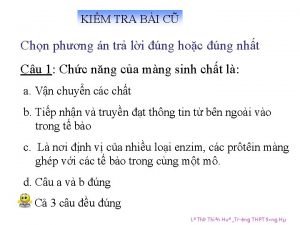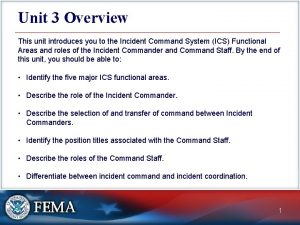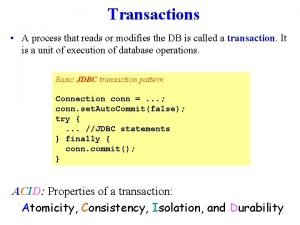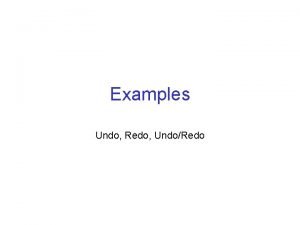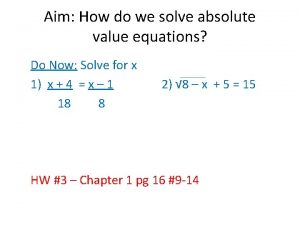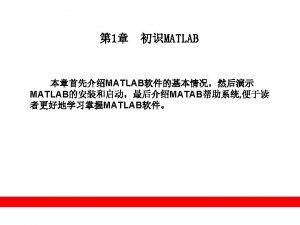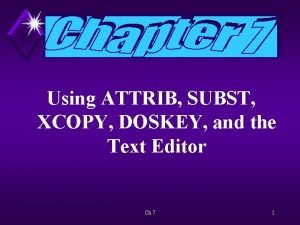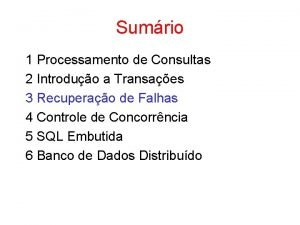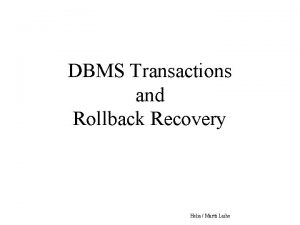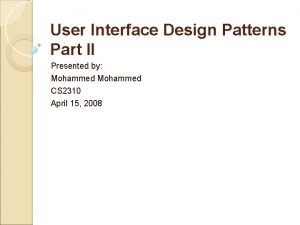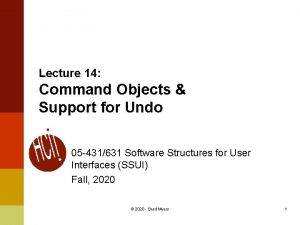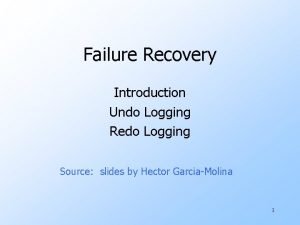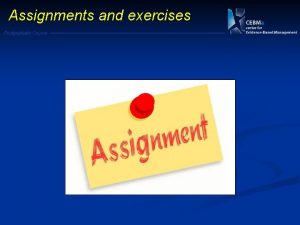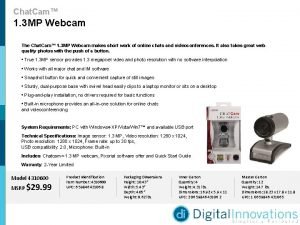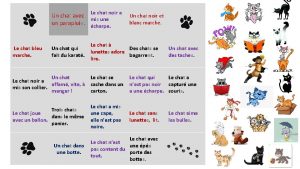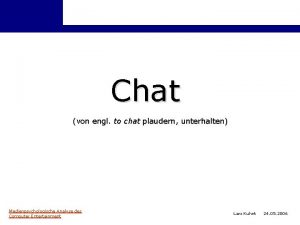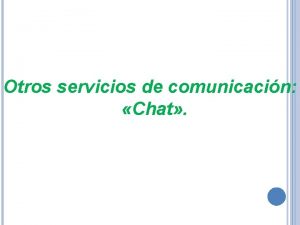Lecture 3 Chat Assignments 2 and 3 Undo






















- Slides: 22

Lecture 3 Chat: Assignments 2 and 3 Undo Capability Fine-tuning appearance Adding Customizability Save/Restore Assignment 4

Undo/Redo Expected by user Apply consistently n n n Second undo = redo? More depth is nice What counts as an event? Easily and non-easily reversible events Warn user when taking irreversible actions Persistency: can undo vector be saved?

1 -step Undo After each reversible action, save state (backend) If Undo command issued: w Restore state. (backend, possibly frontend). w Save undone state in case of redo. w Disable undo, enable redo.

Multi-step undo/redo Keep stack of recent states. Undo pops back to previous state. New actions pushed onto the top. Immediately after a series of undos, can redo actions. Enhanced stack. More complex behavior possible n Emacs’ tree undo

Resource issues with undo Saving/restoring state may cost too much. n n Can store difference between before/after states. Can store command itself. Need special undo code for each command. May only want to support limited undo depth.

Supporting undo in Java Vectors to store states/commands. Dynamically sized and untyped. Need one vector for undoable events and one for redoable events. Can just store Action. Events generated by your UI, rather than state, if you are able to reverse them. Allows highly reusable code.

Images “A picture is worth a thousand words, and uses less screen real estate. ” Attach to a JComponent: Image. Icon ii = new Image. Icon(“images/icon 1. gif”); JButton b = new JButton(ii); JLabel l = new JLabel(“Hello”, ii); JMenu. Item mi = new JMenu. Item(“test”); mi. set. Icon(b. get. Icon()); Manipulate using Graphics or Graphics 2 D object

What can I do in 1 line? Can add images to any Abstract. Button (button, checkbox, menuitem), JLabel, JList, JCombo. Box Only Icons (fixed-size images) supported so far. Use Image. Icon. Dubious support for animated gifs, but these distract even when they do work.

Other Easy Graphic Effects Buttons/Menus can have several icons to indicate status. Change background color of any JComponent using set. Background. set. Foreground too. Use JLayered. Pane to superimpose text, components, on top of image. Can also set. Font().

Example: JButton icons Image. Icon ic 1 = new Image. Icon(filename. Or. URL); // … Get icons ic 2 through ic 6. JButton but = new Jbutton(“text”); but. set. Icon(ic 1); but. set. Rollover. Icon(ic 2); but. set. Pressed. Icon(ic 3); but. set. Selected. Icon(ic 4); but. set. Disabled. Icon(ic 5); but. set. Disabled. Selected. Icon(ic 6); // etc.

Customization “A happy user is a productive user. ” What should we allow the user to change? n n Almost everything Don’t let the user trap himself. no “hide Edit Preferences”, “disable Quit”. Session vs. Permanent prefs no e. g.

Easy part first: Cosmetic customization, such as colors, background screen, menu shortcuts, all easy. Font also easy, except font size may cause problems. Same goes for Icons. Examples

Hard parts (sort of) Permanent prefs. Need to save everything relevant in a file. Prioritized prefs. “I like blue text, except in buttons with icons, except for the Back button. ” Multiple preference settings. Resizing/rearranging GUI components.

Save/Restore A quick overview of stream I/O in Java. n Note: easy to write OS specific code here, because of path name conventions Serialization

Streams Input. Stream Output. Stream

Wrapping A technique for “borrowing methods” Vector. add() Object. Input. Stream int Object Filter. Input. Stream File. Input. Stream Integer int A wrapper class Stream wrapping

Example (Save. Restore. Demo. java) // In action. Performed(Action. Event e) method. // code handles “Save” menuitem by storing a // serialized object to file. if (e. get. Action. Command(). equals("Save")) { try { File. Output. Stream out = new File. Output. Stream(fname); Object. Output. Stream s = new Object. Output. Stream(out); s. write. Object(my. Serializable. Object); s. flush(); } catch (Exception ex) { System. out. println("Save exception. " + ex); }

Object Serialization Uniform way of converting objects to strings, for RMI and saving/restoring from files. Thread-safe. Object cannot be modified during serialization. Objects can only be serialized once by a given serializer. Further references are by handle. This is efficient, but somewhat limiting. Compatibility issues.

Using Serialization Use classes Object. Output. Stream, Object. Input. Stream. Methods write. Object(ob), read. Object() convert any Serializable object to a data stream. Serializable interface is empty. n n Only purpose is security. If you make a class Serializable, its private fields can be accessed. Can override this by providing custom write. Object and read. Object methods in Serializable class, or by declaring variables transient

Custom Serialization Default serialization is inefficient May want to serialize part of a field, but protect another part. May wish to switch between allowing and disallowing serialization, or change methods.

Save/Restore 1 -step save: serialize everything, write it to file. Wasteful. Better: save only as much as necessary, but serialize where handy. Restore: Read from file in reverse order data was written.

Assignment 4 Lots of work, start early. Get totally familiar with Save. Restore. Demo before starting. The new functionality is mostly here.
 Vận chuyển các chất qua màng
Vận chuyển các chất qua màng 01:640:244 lecture notes - lecture 15: plat, idah, farad
01:640:244 lecture notes - lecture 15: plat, idah, farad Which ics functional area sets the incident objectives
Which ics functional area sets the incident objectives Challenge and change in society assignments
Challenge and change in society assignments Ksu fye 1322
Ksu fye 1322 How to undo log
How to undo log Graphing logarithms
Graphing logarithms Kidpix4 free download
Kidpix4 free download How to undo a log
How to undo a log How to undo a exponent
How to undo a exponent How do you undo absolute value
How do you undo absolute value Cut copy paste undo redo
Cut copy paste undo redo Undo subst command
Undo subst command Five things we need to know about technological change
Five things we need to know about technological change Redo undo
Redo undo How to undo an absolute value
How to undo an absolute value Accounting analysis
Accounting analysis Redo undo
Redo undo Redo undo
Redo undo Undo natural log
Undo natural log Undo
Undo Undo
Undo Undo logging
Undo logging
